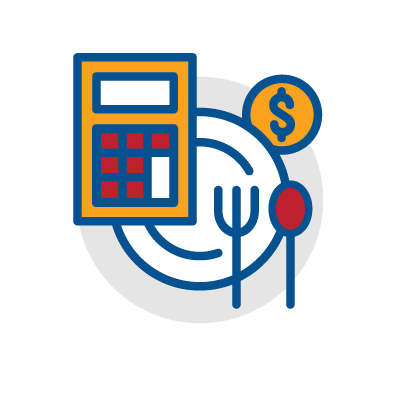 Eating on a Budget
Eating on a Budget
Eating nutritious, satisfying meals doesn't have to be expensive. Senior nutrition programs can provide older adults with tips on how to buy, store, and prepare food in a way that maximizes their budget.
 Tools & Toolkits
Tools & Toolkits
- Thumbs Up for Healthy Choices in Food Pantries— Toolkit to make healthier choices more visible to people receiving food from emergency food sites (Utah State University Extension, 2020)
- Collection of Nutrition Education Resources— Links and archives, including Beneficial Bitesand Eat Well, Age Well(Greater Wisconsin Agency on Aging Resources)
- Discover Foods— Advice for buying, storing, and cooking various foods (EatFresh.org)
- Eating Healthy on a Budget— Handout (HHS, 2011)
- Making Every Dollar Count— Course on managing money (University of California Cooperative Extension, 2009)
- Grocery Budget Calculator— Tool (Iowa State University Extension and Outreach)
 Spend Smart. Eat Smart
Spend Smart. Eat Smart
- Spend Smart. Eat Smart— Strategies to get more for your money (Iowa State University Extension and Outreach, 2017)
- Dairy(2017)
- Fruits(2017)
- Grains(2017)
- Protein(2017)
- Vegetablesand more (2017)
- Cook at Home— Cooking tips and terminology (Iowa State University Extension and Outreach)
 MyPlate Fact Sheets
MyPlate Fact Sheets
- Eat Healthy on a Budget— Benefits and tips on healthy eating (USDA, 2022)
- Kitchen Time Savers — Practical tips for efficient meal preparation (USDA, 2022)
- Make a Meal Plan— Meal planning tips to organize, save money, and choose healthy options (USDA)
- Shop Smart— Tips to buy budget-friendly and healthy options from each food group (USDA)
- Stretching a Holiday Food Budget— Tips from the MyPlate Holiday Makeover series (USDA, 2013)
 SNAP-Ed Resources
SNAP-Ed Resources
- Eat Right When Money’s Tight— Resources for making healthy food choices on a tight budget (USDA)
- Healthy, Thrifty, Holiday Menus — SNAP-Ed Connection recipes (USDA)
- Seasonal Produce Guide — Guide on in-season fruits and vegetables (USDA)
 Quick Guides
Quick Guides
- Are Canned Foods Nutritious for My Family?— Considerations for including canned foods in your diet (Academy of Nutrition and Dietetics, 2022)
- Shelf-stable Foods— Fact sheet about canned vegetables (Greater Wisconsin Agency on Aging Resources, 2019)
- Eating on a Budget — Tips to help your grocery money last longer (Nutrition and Aging Resource Center, 2022)
- Building a Garden at Home— Article on growing your own food (Porch, 2022)
- Best Practices for Reusable Grocery Bags— Article on food safety and care with reusable grocery bags (Virginia Cooperative Extension, 2024)

